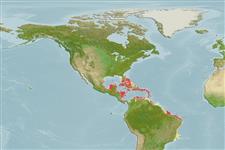Common names from other countries
Teleostei (teleosts) >
Gobiiformes (Gobies) >
Gobiidae (Gobies) > Gobiinae
Etymology: Bathygobius: Greek, bathys = deep + Latin, gobius = gudgeon (Ref. 45335).
Environment: milieu / climate zone / depth range / distribution range
Ecology
Marine; demersal. Tropical; 32°N -
Western Atlantic: Bermuda, Florida (USA), and the Bahamas to northern South America.
Size / Weight / Age
Maturity: Lm ? range ? - ? cm
Max length : 7.5 cm TL male/unsexed; (Ref. 7251)
Dorsal spines (total): 6 - 7; Dorsal soft rays (total): 9; Anal spines: 1; Anal soft rays: 8. This species is distinguished by the following characters: 16-17 pectoral fin rays (rarely 15 or 18); 31-36 lateral scale rows; upper jaw length 11.1-15.0 % SL; predorsal squamation extending anteriorly to vertical through posterior margin of preopercle, sometimes slightly beyond this point; body variously covered in dark blotches, sometimes loosely forming 6-7 diffuse dark blotches of varying size down body, trunk typically with no apparent diagnostic pattern of pigment (Ref. 85559).
Inhabits tide pools and shore waters, including mangrove areas (around muddy substrate near mangrove roots) and sheltered seagrass beds (rock and turtle grass) (Ref. 7251, 85559).
Life cycle and mating behavior
Maturities | Reproduction | Spawnings | Egg(s) | Fecundities | Larvae
Robins, C.R. and G.C. Ray, 1986. A field guide to Atlantic coast fishes of North America. Houghton Mifflin Company, Boston, U.S.A. 354 p. (Ref. 7251)
IUCN Red List Status (Ref. 130435)
CITES (Ref. 128078)
Not Evaluated
Threat to humans
Harmless
Human uses
Tools
Special reports
Download XML
Internet sources
Estimates based on models
Preferred temperature (Ref.
115969): 26.4 - 28.2, mean 27.5 (based on 587 cells).
Phylogenetic diversity index (Ref.
82804): PD
50 = 0.5000 [Uniqueness, from 0.5 = low to 2.0 = high].
Bayesian length-weight: a=0.00708 (0.00333 - 0.01504), b=3.09 (2.92 - 3.26), in cm Total Length, based on LWR estimates for this (Sub)family-body shape (Ref.
93245).
Trophic level (Ref.
69278): 3.4 ±0.5 se; based on size and trophs of closest relatives
Resilience (Ref.
120179): High, minimum population doubling time less than 15 months (Preliminary K or Fecundity.).
Fishing Vulnerability (Ref.
59153): Low vulnerability (10 of 100).
